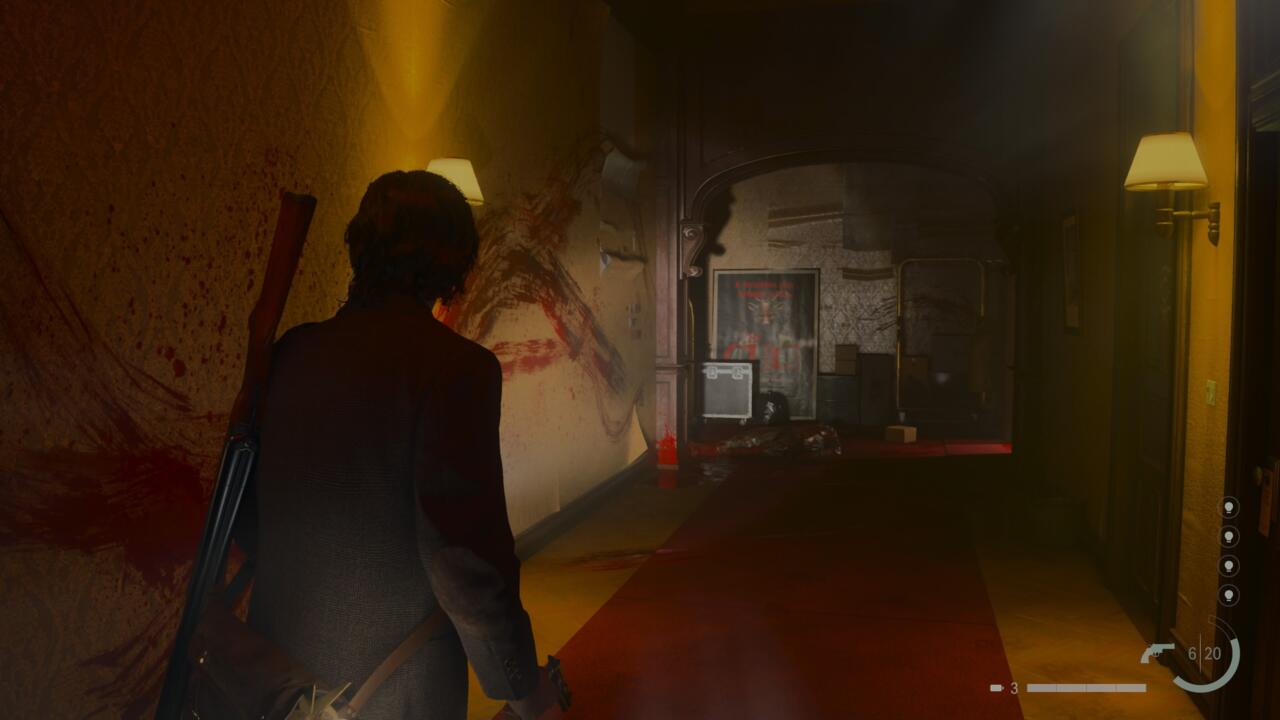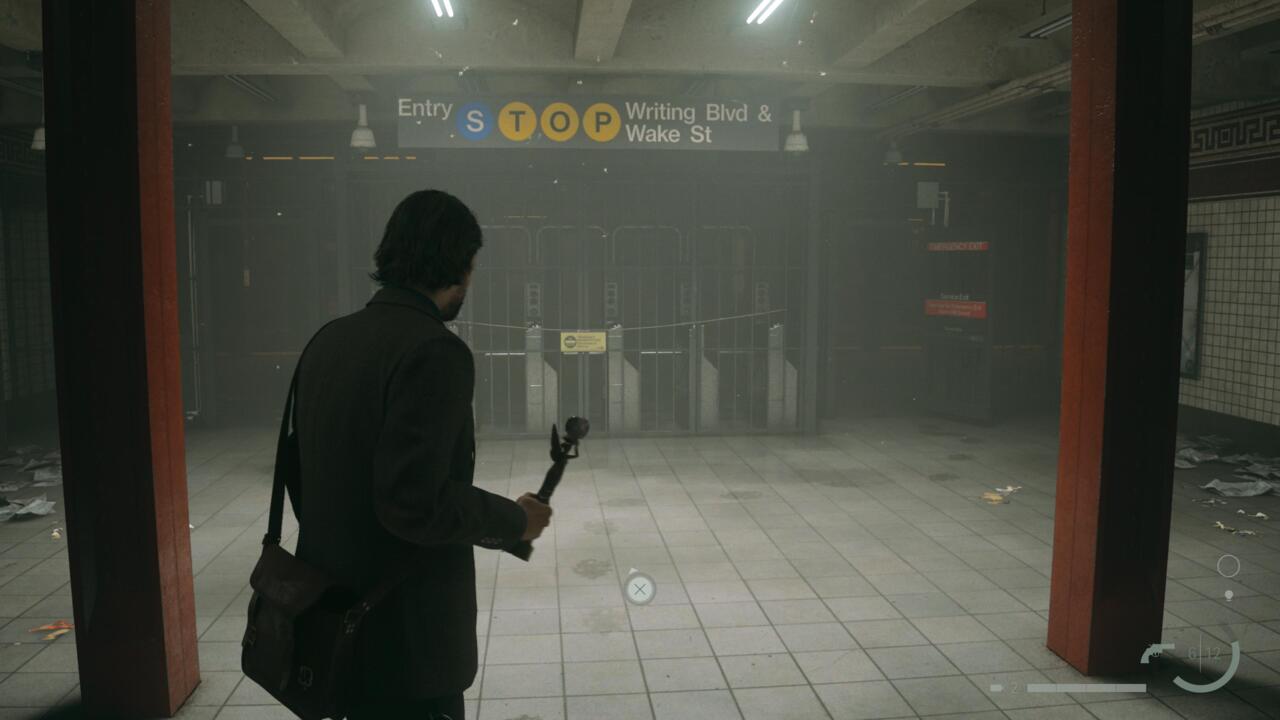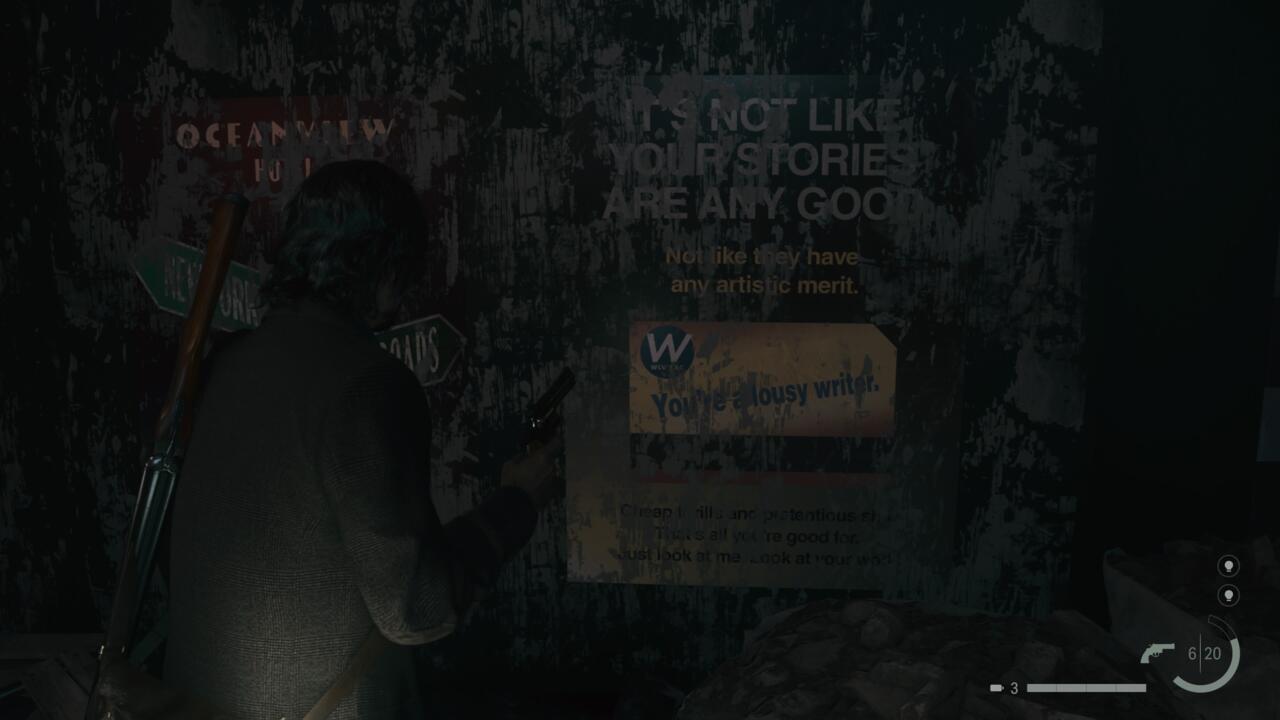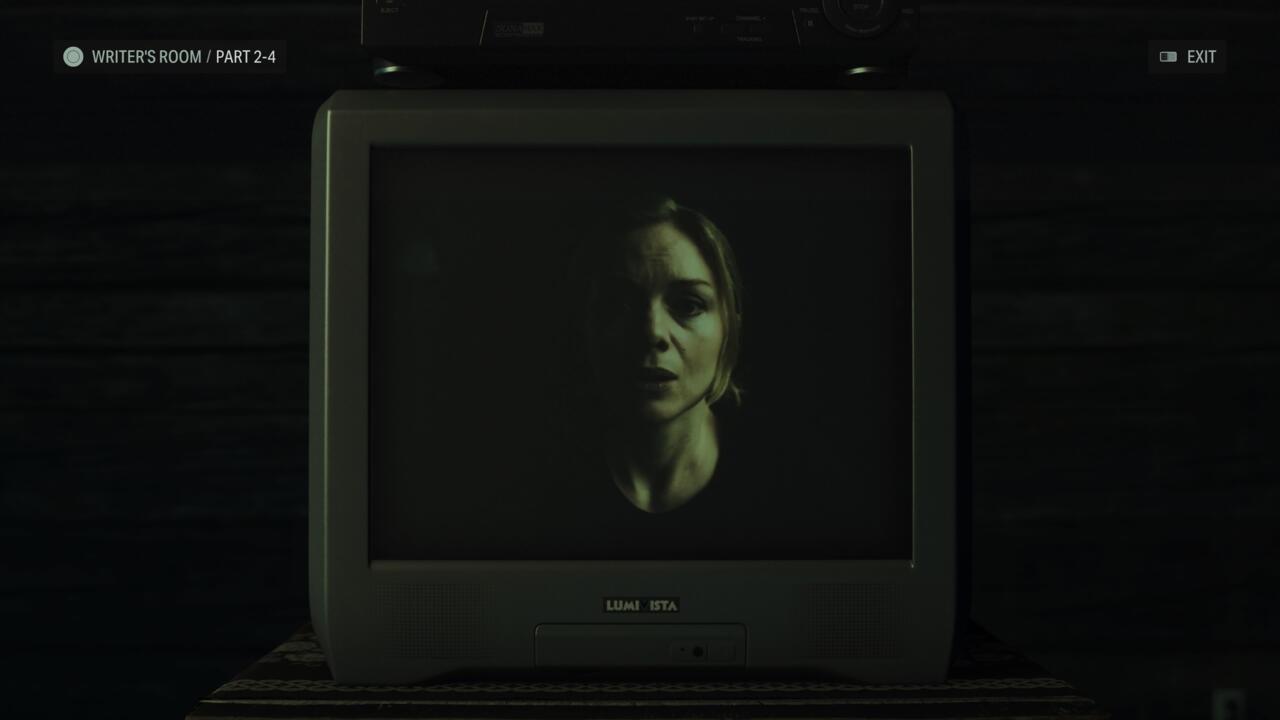Warning: We’re spoiling here. We’re trying to keep it light but it’s probably best you play Alan Wake 2 before reading this.
Captivating as Alan Wake 2 often is, it can occasionally get a bit … cringey. But not in the wild, over-the-top moments where cheese and kitsch meet murderous intent (you know the scene I mean); Alan Wake 2’s funny, weird moments channel the best of stories such as Twin Peaks, leveraging an absurdity and surrealism that actually makes the story more human. It’s when Alan Wake 2 takes itself seriously that it starts to become a little hard to stomach.
There’s a whole level that really encapsulates this feeling of near-goofy grittiness: the Oceanview Hotel. A shifting location in the alternate reality of the Dark Place, the Oceanview is not strictly an actual place, but rather manifested from some combination of forces, including eponymous protagonist Alan’s writing. He is, of course, trying to free himself from the Dark Place by using its power, which can make art into reality both within the Dark Place itself and back out in the real-world town of Bright Falls, Washington.
The Oceanview changes as you venture through it as Alan is inspired by “echoes,” which seem to be some combination of half-remembered past story ideas, things he’s read or written, and glimpses of actual events in the real world. Finding the echoes lets him write new scenes, which change the world of the Dark Place around him to fit the crafted narrative. As he changes the story, the Oceanview becomes the site of a play about a cult, apparently staged by that cult. But at some point, Alan’s inspiration sends a murderer rampaging through the Oceanview. It becomes a setting littered with bodies and absolutely bathed in blood, as if this were not the Oceanview but the Overlook Hotel and all the elevators opened up to let rivers of blood erupt through the halls.
It feels like this is meant to be scary. It is not.
The Oceanview is, honestly, hacky. It strains credulity in a world literally remade by fiction and centered on a neo-noir detective story about–and really let this sink in–an Alan Wake-worshiping murder cult.
Here’s the thing: The cringe is the point. Others have noted, for a while now, that the in-universe writer Alan is maybe, possibly, potentially, uh… not great? At, you know, writing. He’s popular, sure. But he is perhaps not actually good.
Somewhat mesmerizingly, the fact that Alan is a hack and that his hack writing translates into a hack world he has to hack his way through is a beautiful extension of both the game’s core conflict and of its underlying thematic drive. Alan has been trying to write his way out of the Dark Place for more than a decade and can’t seem to pull it off. After a while, you’d think the guy would start to wonder why.
Alan Wake 2 is about setting expectations and failing to meet them, and realizing you might never meet them because it’s quite possible that you suck at this. By this, I mean writing. Making video games. Creating art in general. That’s the centerpiece of Alan’s whole journey, and it’s the struggle Remedy Entertainment and lead writer Sam Lake are working through across the game’s entire runtime. The cringe is the point.

The first Alan Wake is about a writer struggling with his own success. Tired of retreading the same ground with the same character, he kills off his long-running protagonist and then immediately finds himself blocked. He winds up trying to write something new, jumps genres, and flails around a lot. He ends up writing the story about himself, drawing on the real world not just for inspiration but for literal content.
In perfect Remedy fashion, that maps onto the meta story of Lake and Remedy’s situation at the time. Alan Wake was a genre shift after two successful Max Payne games, and it turns into a story about the writing process, the struggle to do something new and interesting in the face of past success, and the anger and frustration that result.
Take that same approach to analyzing Alan Wake 2 and you get Remedy grappling with different internal struggles. The studio has clearly been thinking about this game for a long while–it had the spin-off game Alan Wake’s American Nightmare and the “This House of Dreams” ARG blog in 2012, and references to a lot of the elements that would become Alan Wake 2 in 2016’s Quantum Break. But 13 years is a long time, and expectations were high. Could Alan Wake 2 ever be good enough to meet them? Were Lake, his co-writers Clay Murphy and Tyler Burton Smith, and Remedy itself up to the task of actually creating what they had envisioned?
It’s exactly the difficulty Alan faces, and some of the best elements of the game externalize these fears. Wander through the Dark Place’s New York, in particular its subway stations, and you’ll notice that all the typical signage telling you which trains go where and which gaps to mind are actually populated by text from Alan’s manuscript. Sprinkled among those are some that project Alan’s unarticulated fears onto the world around him. They read like the self-doubting internal monologue any creator will recognize as it says, “It’s not like you’re any good, anyway.”
And then there are those that go a step further, imploring him to a single, all-important action: “Stop writing.”

There’s no stretch required to see this as the writers working out their own issues within the game in real time. It’s a brilliant approach, though, because Alan never quite deals with those externalized internal voices. He just … ignores them. He passes them by, like a Westworld bot presented with a photograph showing inconvenient information. Those signs that tell Alan he sucks don’t look like anything to him. After all, how can a hack know he’s a hack, especially when he’s met with so much success?
The game addresses these ideas with the implicit understanding that having all those thoughts, and intellectually taking an outside perspective to analyze them within yourself, just amplifies them further. It’s imposter syndrome rendered interactive on the screen, the lines between character and player and developer all blurring together. Am I playing as the hack, or is he me?
If you catch all of the Writer’s Journey videos, the little snippets of live-action footage of Alan writing in the Dark Place that are scattered around as collectibles in Alan’s levels, you see the actual descent of his character throughout the story. They come off as madness, but they’re actually pretty cogent. They’re about Alan struggling to make art and feeling like he’s not good enough–and eventually coming to terms with that fact. After 13 years of trying to write himself out of the Dark Place with several aborted attempts (including Alan Wake’s DLC stories, The Signal and The Writer, and Alan Wake’s American Nightmare), he realizes that he’s doing more harm than good. “Don’t write” wasn’t Alan’s inner voice chiding him, but his own realization about the destruction his failure was wreaking. Go back to Alan Wake 1 for a second and recall that Alan’s writer’s block, his inability to create at the level of his own expectation, was causing an undirected rage in him that was midway through consuming his marriage.
The last video of the series sees Alan forgetting his own revelation thanks to the Dark Place’s effects on his mind and starting a new draft, repeating the same self-destructive, inescapable loop he’s been stuck in all along.


Alan Wake 2 is about being successful and wondering if you deserve it, the battle with yourself to create something powerful and meaningful, and the realization that, by its very nature, it can never live up to what you hope it could be. And that leads to a final, all-important revelation in Alan Wake 2, and a setup for where things seem likely to go with the “additional narrative” of the upcoming New Game Plus mode, although neither Alan nor Remedy makes a very big deal out of it in the moment.
The thing that changes, that has to change for the story to resolve itself, is that Alan needs a collaborator. Or as it seems to be happening at the end of Alan Wake 2, more than one.
Given the meta nature of the Alan Wake stories, I can’t help but wonder what the process of creating Alan Wake and Alan Wake 2 was like, and if Alan’s experience continues to reflect Lake and Remedy’s. In the case of Alan Wake 2, despite its downbeat conclusion, the idea of Alan seeking collaboration with others is undeniably hopeful. It’s Alan’s work with Saga Anderson that allows him to write a working ending for Return, the story that’s coming to life throughout the game. And the mid-credits scene suggests that Alan’s future collaborations will also include his wife, Alice.
The way the game portrays Alice and Alan’s relationship, both maritally and artistically, is of Alan overshadowing Alice. What work they do together–Alice photographing Alan for book jacket author blurbs–is presented as him throwing his wife a bone rather than working with an equal. And it’s only by literally exorcizing Alan through her work that Alice finally seems to reach the heights she’s been trying to attain as an artist. The idea of them working together on art that can save his life, as equals, sounds like it will require Alan to grow as a person.


And that’s kind of the whole point. The idea that Alan is a hack feels like it’s derivative of a mentality of someone who needs to grow up. Alan is kind of a self-absorbed jerk in the first game, after all, and it’s only through the course of that story that he becomes someone not just willing to brave dangers for the sake of others, but capable of self-sacrifice at all.
Alan still has maturing to do, though, as we can see from an Oceanview Hotel that’s not just the site of murders, but of ludicrous, blood-drenched murders, so over-the-top in their darkness that they become campy. He (apparently) writes Saga and her family into the story without much real thought of the consequences their inclusion would actually have on them, and it’s Saga’s intervention, not Alan’s, that saves her daughter, Logan, and her partner, Alex Casey (or at least is meant to). Alan needs collaboration because others can bring different perspectives to Alan that he needs to create the art he longs to make.
With that realization, Alan Wake 2 dispels what is often the popular view of art, of the sort of tortured, genius auteur feverishly bringing something into the world through nothing more than sheer will. Art often isn’t like that. Alan Wake 2 has a more cooperative, expansive view on it, in which relationships flesh out our creativity just like our lives.
Alan Wake 2 is a story about a hack writer coming to terms with his limitations and seeking to expand beyond them. It’s a story about artists dealing with feelings of imposter syndrome and the fear of trying, and maybe failing, to create something great. And maybe what Alan, and by extension the rest of us, need to learn is to let go of the expectations in order to succeed.
The products discussed here were independently chosen by our editors.
GameSpot may get a share of the revenue if you buy anything featured on our site.